Optical Properties of BaAl2O4 Due to Cerium Doping and Heat Treatment in Different Atmospheres
Abstract
1. Introduction
2. Experimental Section
2.1. Preparation of BaAl2O4: Ce Samples
2.2. Characterization of BaAl2O4: Ce Samples
3. Results and Discussion
4. Conclusions
Author Contributions
Funding
Data Availability Statement
Acknowledgments
Conflicts of Interest
References
- Ziyauddin, M.; Brahme, N.; Shrivastava, A.K. Luminescence Properties of BaAl2O4: Eu2+ Phosphors. Int. Res. J. Eng. Technol. 2018, 5, 3656–3660. [Google Scholar]
- Wang, S.; Gao, H.; Fang, L.; Wei, Y.; Li, Y.; Lei, L. Synthesis and Characterization of BaAl2O4 Catalyst and its Photocatalytic Activity Towards Degradation of Methylene Blue Dye. Z. Phys. Chem. 2018, 233, 1161–1181. [Google Scholar] [CrossRef]
- Kumar, G.K.; Bhargav, B.P.; Aravinth, K.; Balaji, C. Enhanced photoluminescence properties of BaAl2O4: Ce3+/Li+ yellow phosphors. J. Mater. Sci. Mater. Electron. 2022, 33, 15323–15332. [Google Scholar] [CrossRef]
- Ren, J.; Lin, L.; Lieutenant, K.; Schulz, C.; Wong, D.; Gimm, T.; Bande, A.; Wang, X.; Petit, T. Role of Dopants on the Local Electronic Structure of Polymeric Carbon Nitride Photocatalysts. Small Methods 2021, 5, 2000707. [Google Scholar] [CrossRef] [PubMed]
- Melo, S.S.; Andrade, A.B.; Bispo, G.; Carvalho, J.; Macedo, Z.; Valerio, M.E. X-ray absorption spectroscopy and tunable color emission study of the Mnco-doped BaAl2O4:Ce phosphor under synchrotron radiation. Opt. Mater. 2019, 91, 401–407. [Google Scholar] [CrossRef]
- Khanin, V.; Venevtsev, I.; Chernenko, K.; Pankratov, V.; Klementiev, K.; van Swieten, T.; van Bunningen, A.J.; Vrubel, I.; Shendrik, R.; Ronda, C.; et al. Exciton interaction with Ce3+and Ce4+ ions in (LuGd)3(Ga,Al)5O12 ceramics. J. Lumin. 2021, 237, 118150. [Google Scholar] [CrossRef]
- Chatterjee, R.; Saha, S.; Panigrahi, K.; Ghorai, U.K.; Das, G.C.; Chattopadhyay, K.K. Blue Emitting BaAl2O4:Ce3+ Nanophosphors with High Color Purity and Brightness for White LEDs. Microsc. Microanal. 2019, 25, 1466–1470. [Google Scholar] [CrossRef]
- Gedekar, K.A.; Wankhede, S.P.; Moharil, S.V.; Belekar, R.M. d–f luminescence of Ce3+ and Eu2+ ions in BaAl2O4, SrAl2O4 and CaAl2O4 phosphors. J. Adv. Ceram. 2017, 6, 341–350. [Google Scholar] [CrossRef]
- Chatterjee, R.; Das, G.C.; Chattopadhyay, K.K. Synthesis and characterization of highly luminescent green emitting BaAl2O4: Tb3+ nanophosphors. Mater. Today Proc. 2017, 18, 1132–1137. [Google Scholar] [CrossRef]
- Rezende, M.; Andrade, A.; Paschoal, C. Co-doping effect of Ca2+ on luminescent properties of BaAl2O4:Eu3+. J. Electron Spectrosc. Relat. Phenom. 2018, 225, 62–65. [Google Scholar] [CrossRef]
- Wiglusz, R.; Grzyb, T. Sol–gel synthesis of micro and nanocrystalline BaAl2O4:Eu3+ powders and their luminescence properties. Opt. Mater. 2013, 36, 539–5455. [Google Scholar] [CrossRef]
- Rodrigues, L.C.; Hölsä, J.; Carvalho, J.M.; Pedroso, C.C.; Lastusaari, M.; Felinto, M.C.; Watanabe, S.; Brito, H.F. Co-Dopant Influence on the Persistent Luminescence of BaAl2O4:Eu2+, R3+. Phys. B 2014, 439, 67–71. [Google Scholar] [CrossRef]
- Jia, D.; Wang, X.-J.; Kolk, E.v.d.; Yen, W. Site dependent thermoluminescence of long persistent phosphorescence of BaAl2O4:Ce3+. Opt. Commun. 2002, 204, 247–251. [Google Scholar] [CrossRef]
- Catauro, M.; Tranquillo, E.; Poggetto, G.D.; Pasquali, M.; Dell’era, A.; Ciprioti, S.V. Influence of the Heat Treatment on the Particles Size and on the Crystalline Phase of TiO2 Synthesized by the Sol-Gel Method. Materials 2018, 11, 2364. [Google Scholar] [CrossRef] [PubMed]
- Younis, A.; Chu, D.; Li, S. Cerium Oxide Nanostructures and their Applications. Funct. Nanomater. 2016, 3, 53–68. [Google Scholar] [CrossRef]
- Hosseini, M.; Amjadi, I.; Mohajeri, M.; Mozafari, M. Sol–Gel Synthesis, Physico-Chemical and Biological Characterization of Cerium Oxide/Polyallylamine Nanoparticles. Polymers 2020, 12, 1444. [Google Scholar] [CrossRef]
- Martos, M.; López, B.; Folgado, J.V.; Cordoncillo, E.; Escribano, P. Sol-gel synthesis of tunable cerium titanate materials. Eur. J. Inorg. Chem. 2007, 2008, 3163–3171. [Google Scholar] [CrossRef]
- Hema, N.; Kumar, K.G.; Lakshmi, M.A.D.; Abbas, M.; Kuppusamy, M. Impact of Dy3+ and Ce3+ ion doping on the photoluminescence, thermoluminescence, and electrochemical properties of strontium aluminate (SrAl2O4) and barium aluminate (BaAl2O4) phosphors. J. Mater. Sci. Mater. Electron. 2024, 35, 923. [Google Scholar] [CrossRef]
- Will, G. Powder Diffraction: The Rietveld Method and the Two Stage Method to Determine and Refine Crystal Structures from Powder Diffraction Data; Springer: Berlin/Heidelberg, Germany, 2006. [Google Scholar]
- Vrankic, M.; Gržeta, B.; Lützenkirchen-Hecht, D.; Bosnar, S.; Šaric, A. Chromium Environment within Cr-Doped BaAl2O4: Correlation of X ray Diffraction and X ray Absorption Spectroscopy Investigations. Inorg. Chem. 2015, 54, 11127–11135. [Google Scholar] [CrossRef]
- Moulder, J.F.; Stickle, W.F.; Sobol, P.E.; Bomben, K.D. Handbook of X-Ray Photoelectron Spectroscopy: A Reference Book of Standard Spectra for Identification and Interpretacion of XPS Data; Division, P.E., Ed.; Perkin-Elmer Corporation: Waltham, MA, USA, 1992. [Google Scholar]
- Zhang, C.; Lin, J. Visible-light induced oxo-bridged ZrIV-O-CeIII redox centre in tetragonal ZrO2-CeO2 solid solution for degradation of organic pollutants. Phys. Chem. Chem. Phys. 2011, 13, 3896–3905. [Google Scholar] [CrossRef]
- Faisal, S.; Majid, S.S.; Ahad, A.; Sofi, F.A.; Mohanta, S.; Gupta, M.; Sahu, P.; Hsieh, W.-P.; Srivastava, H.; Ikram, M.; et al. Photocatalytic Activity of BaAl2O4 for Water Purification. Langmuir 2024, 40, 8418–8426. [Google Scholar] [CrossRef] [PubMed]
- Mahi, K.; Mosfeta, R. Characterization of Magnesium/Barium Aluminates Spinel Synthesized by Sol-Gel Auto-Combustion Method. J. Nano Electron. Phys. 2022, 1–5. [Google Scholar] [CrossRef] [PubMed]
- Shivaramu, N.J.; Coetsee, E.; Roos, W.D.; Nagabhushana, K.R.; Swart, H.C. Charge carrier trapping processes in un-doped and BaAl2O4:Eu3+ nanophosphor for thermoluminescent dosimeter applications. J. Phys. D Appl. Phys. 2020, 53, 475305. [Google Scholar] [CrossRef]
- Wang, S.; Wang, Y.; Gao, H.; Li, J.; Fang, L.; Yu, X.; Tang, S.; Zhao, X.; Sun, G. Synthesis and characterization of BaAl2O4:Ce and Mn-Ce-co-doped BaAl2O4 composite materials by a modified polyacrylamide gel method and prediction of photocatalytic activity using artificial neural network (ANN) algorithm. Opt.-Int. J. Light Electron Opt. 2020, 221, 165363. [Google Scholar] [CrossRef]
- Pandey, A.; Chithambo, M.L. Thermoluminescence of the persistent-luminescence phosphor, BaAl2O4; A stuffed tridymite. Radiat. Meas. 2018, 120, 73–77. [Google Scholar] [CrossRef]
- Zhai, B.-G.; Ma, Q.-L.; Xiong, R.; Li, X.; Huang, Y.M. Blue–green afterglow of BaAl2O4:Dy3+ phosphors. Mater. Res. Bull. 2016, 75, 1–6. [Google Scholar] [CrossRef]
- Maphiri, V.; Mhlongo, M.; Hlatshwayo, T.; Motaung, T.; Koao, L.; Motloung, S.V. Citrate sol-gel synthesis of BaAl2O4:x% Cu2+ (0 ≤ x ≤ 1) nano-phosphors. Opt. Mater. 2020, 109, 110244. [Google Scholar] [CrossRef]
- Mao, Q.; Ji, Z.; Yuan, Q.; Xi, J.; Kong, Z.; Zhang, J. Effects of boric acid on structural and luminescent properties of BaAl2O4:(Eu2+, Dy3+) phosphors. Res. Chem. Intermed. 2016, 42, 6557–6566. [Google Scholar] [CrossRef]
- Origin(Pro), version number 2019b; OriginLab Corporation: Northampton, MA, USA, 2019.
- Raja, A.; Annadurai, G.; Daniel, D.J.; Ramasamy, P. Synthesis, structural and optical properties of Eu3+ activated fluoroperovskite (RbMgF3) phosphors. J. Alloys Compd. 2017, 727, 215–223. [Google Scholar] [CrossRef]
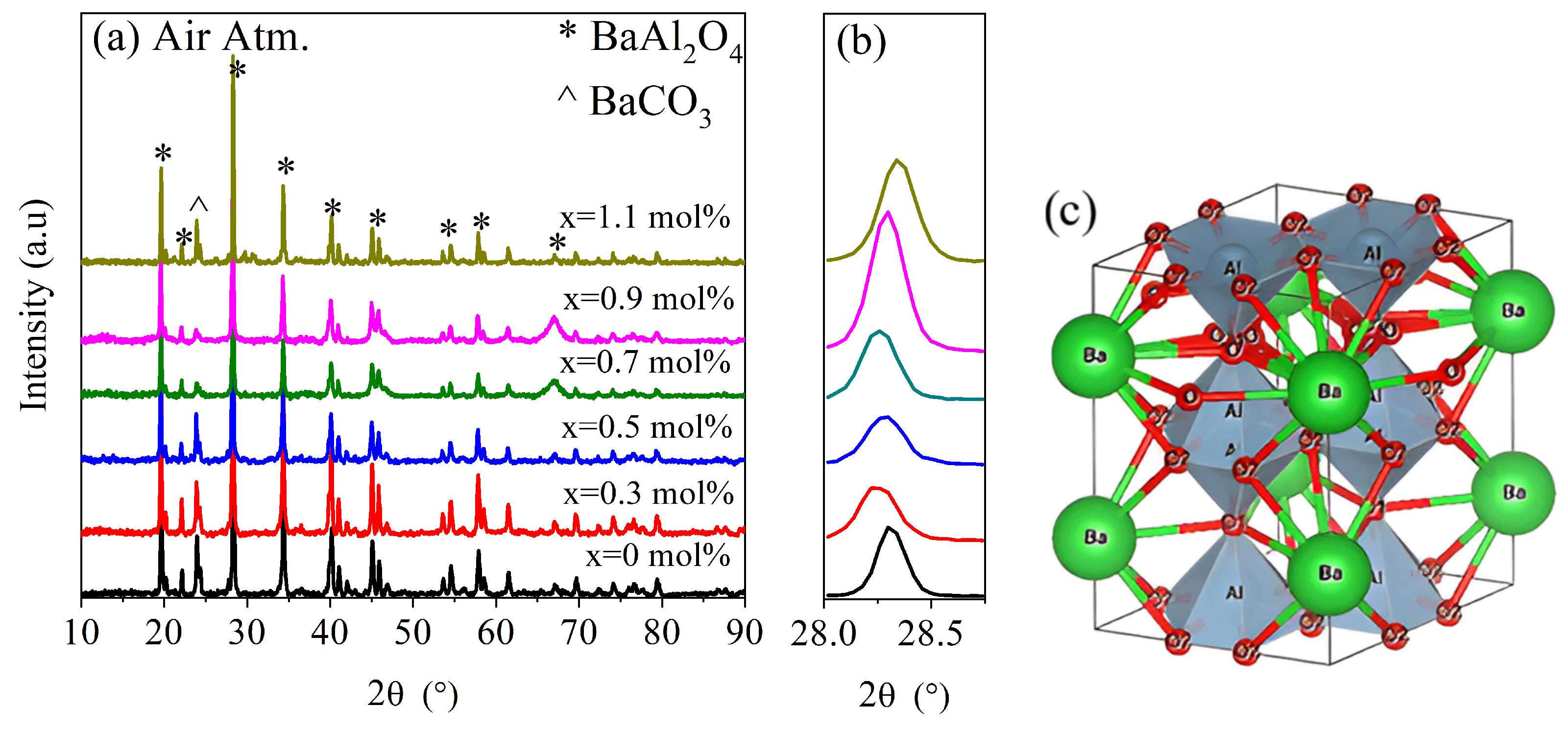
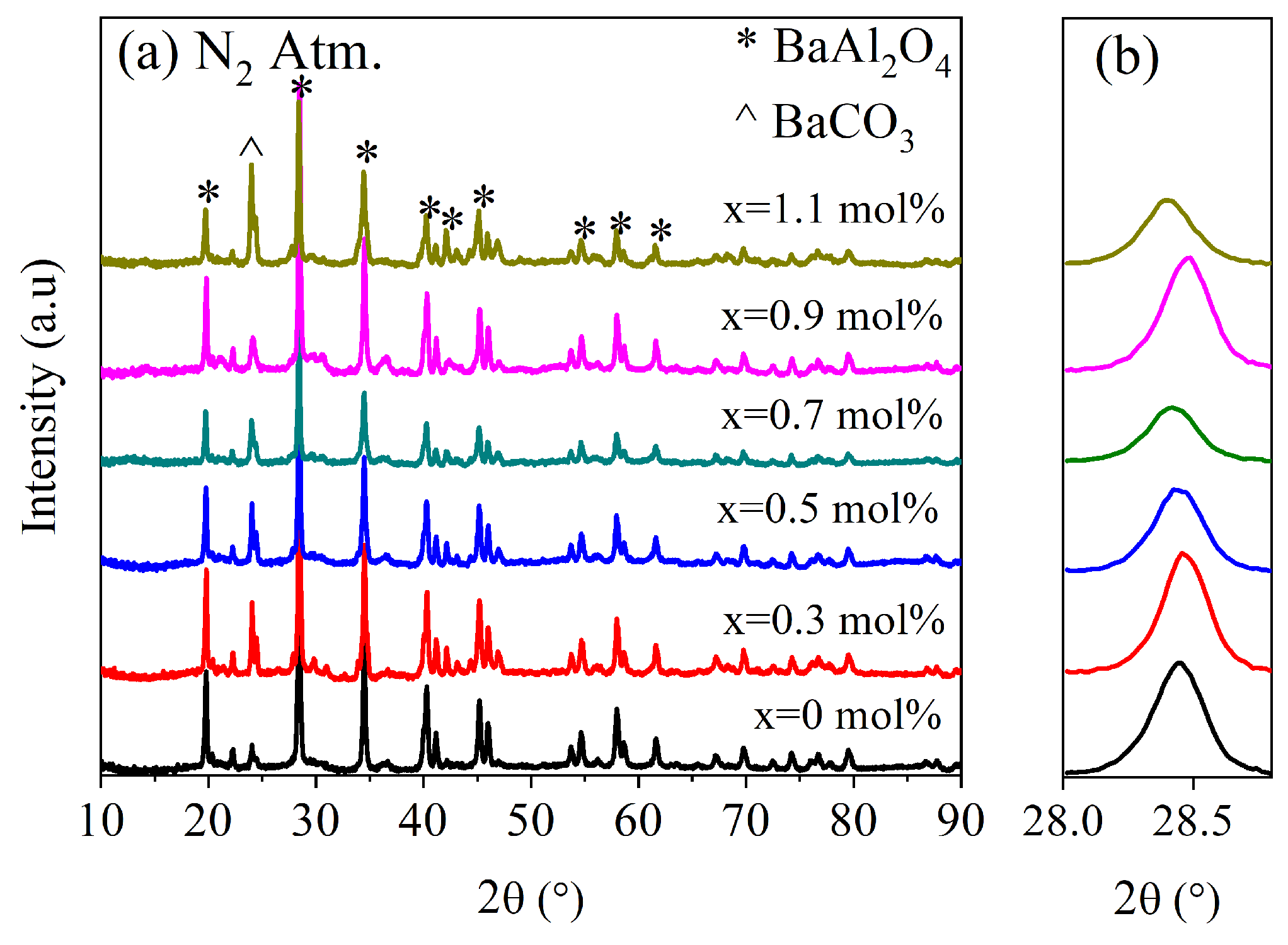
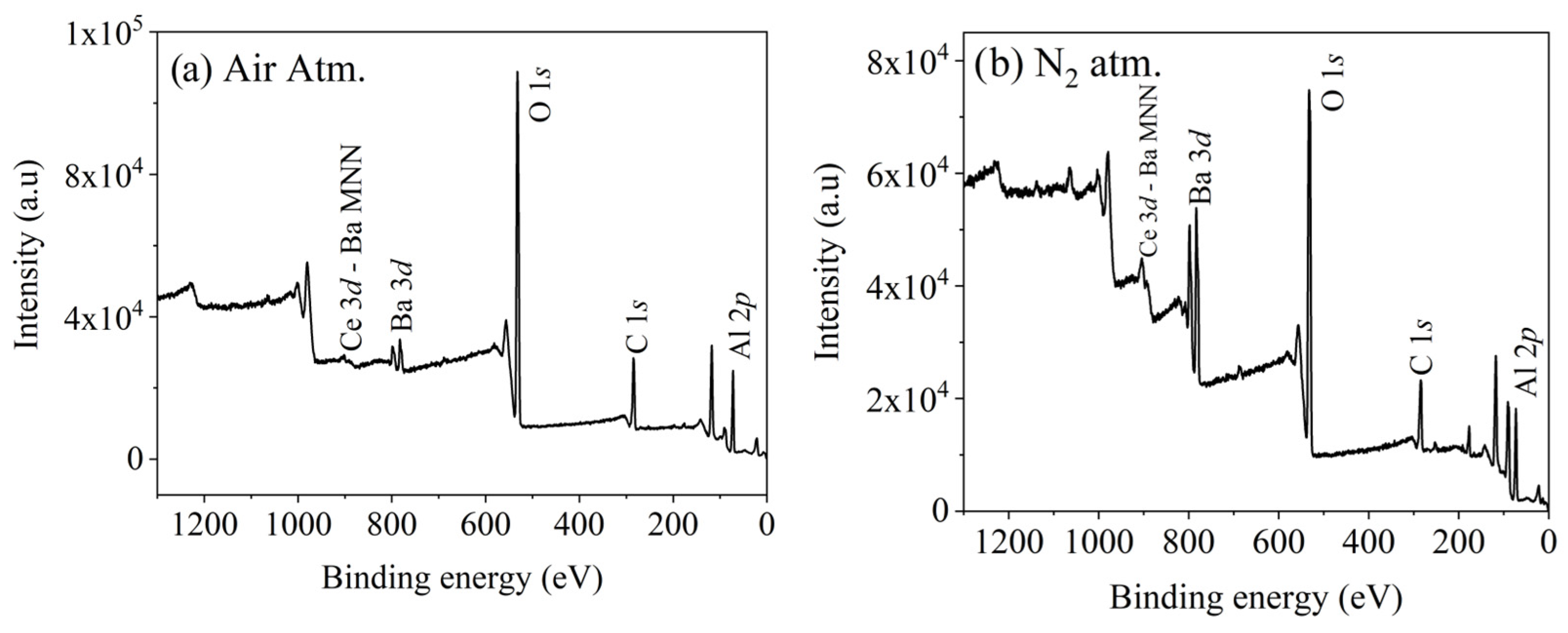

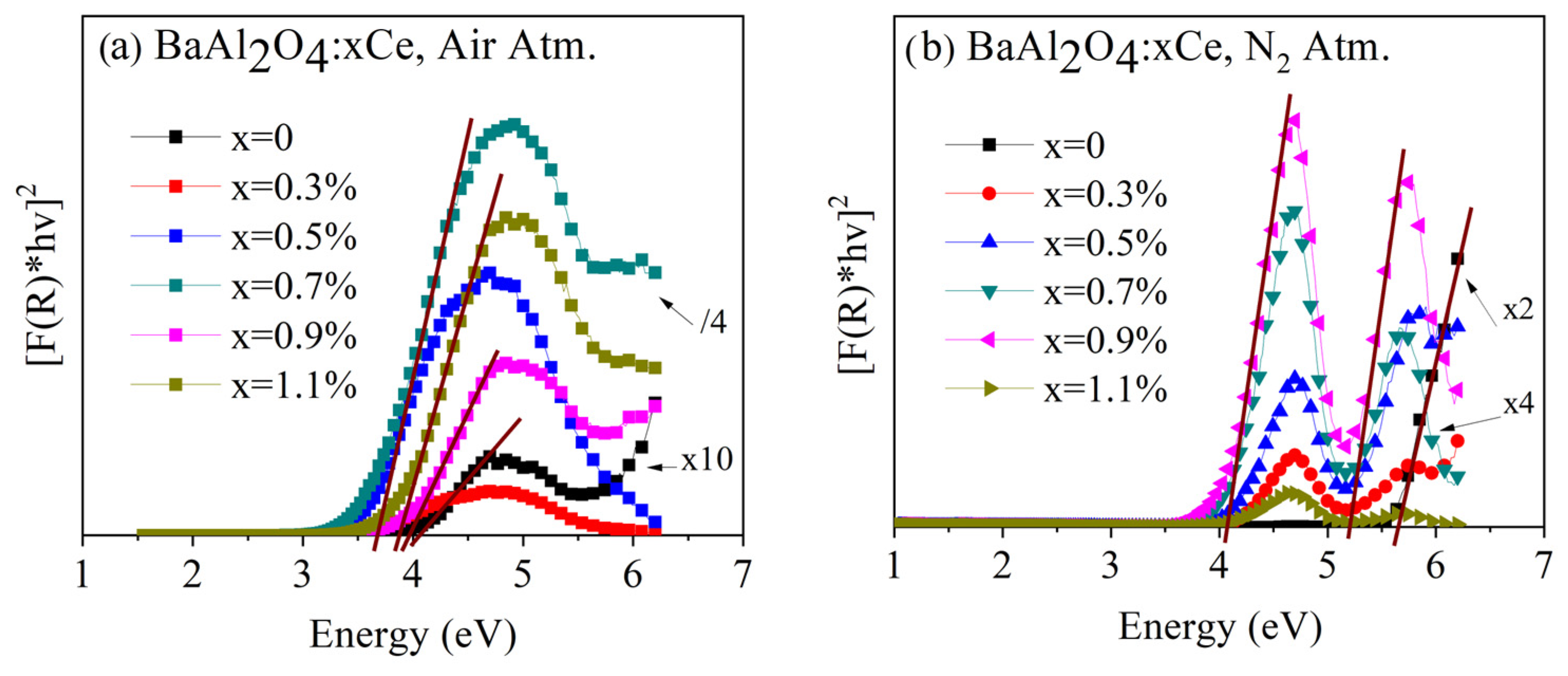
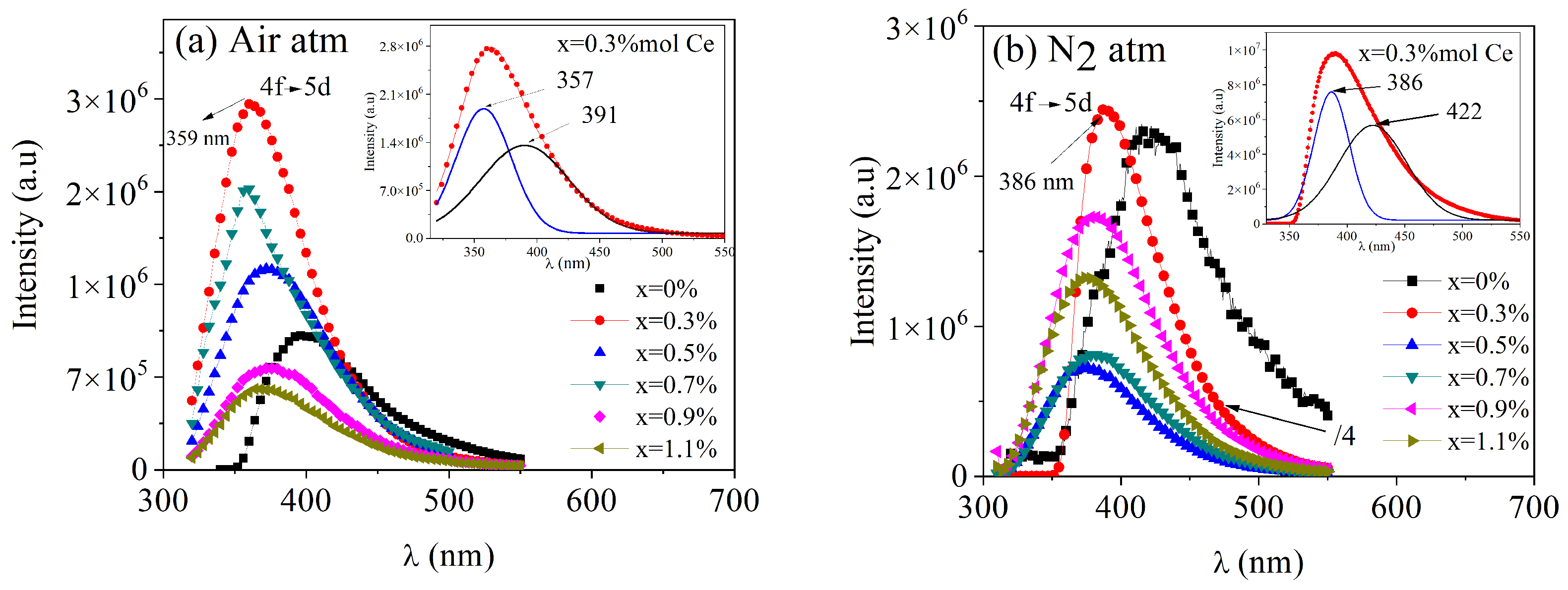
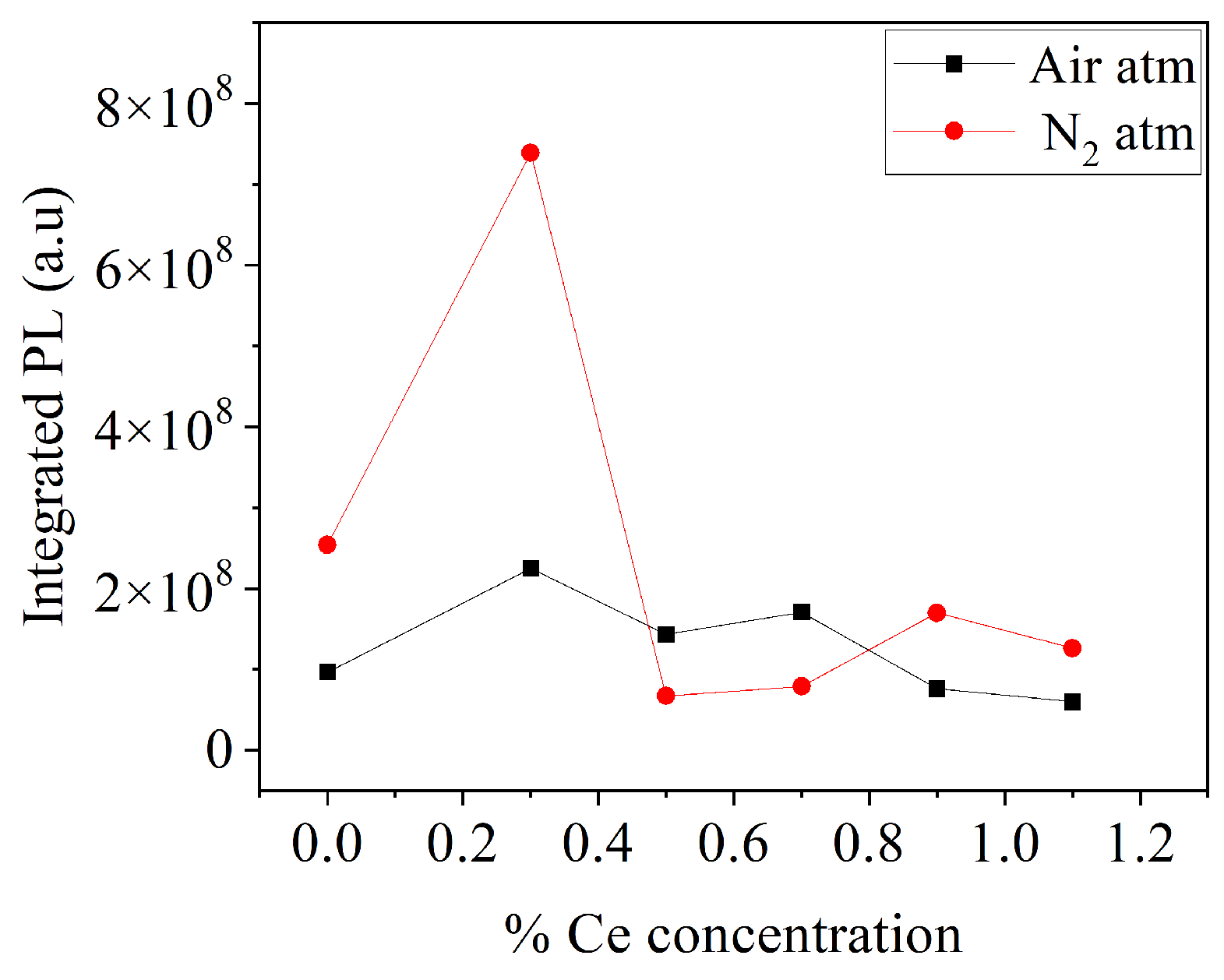
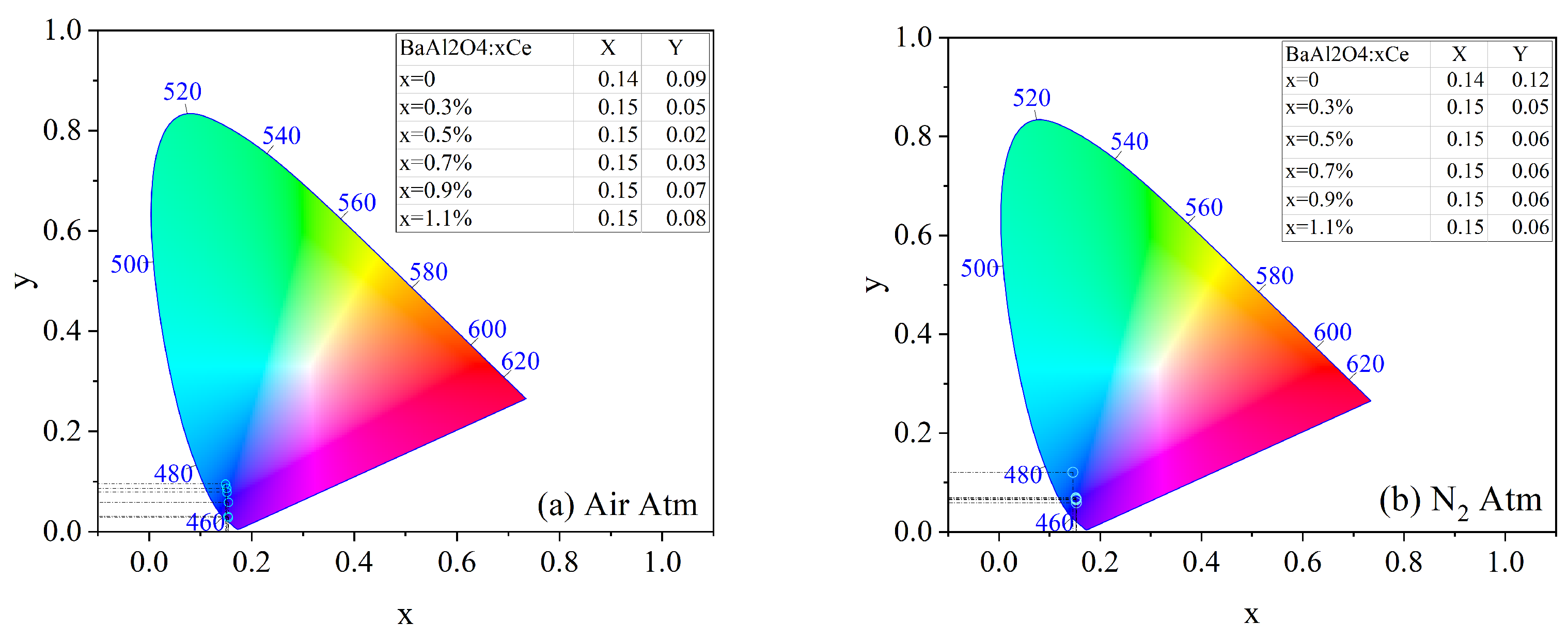
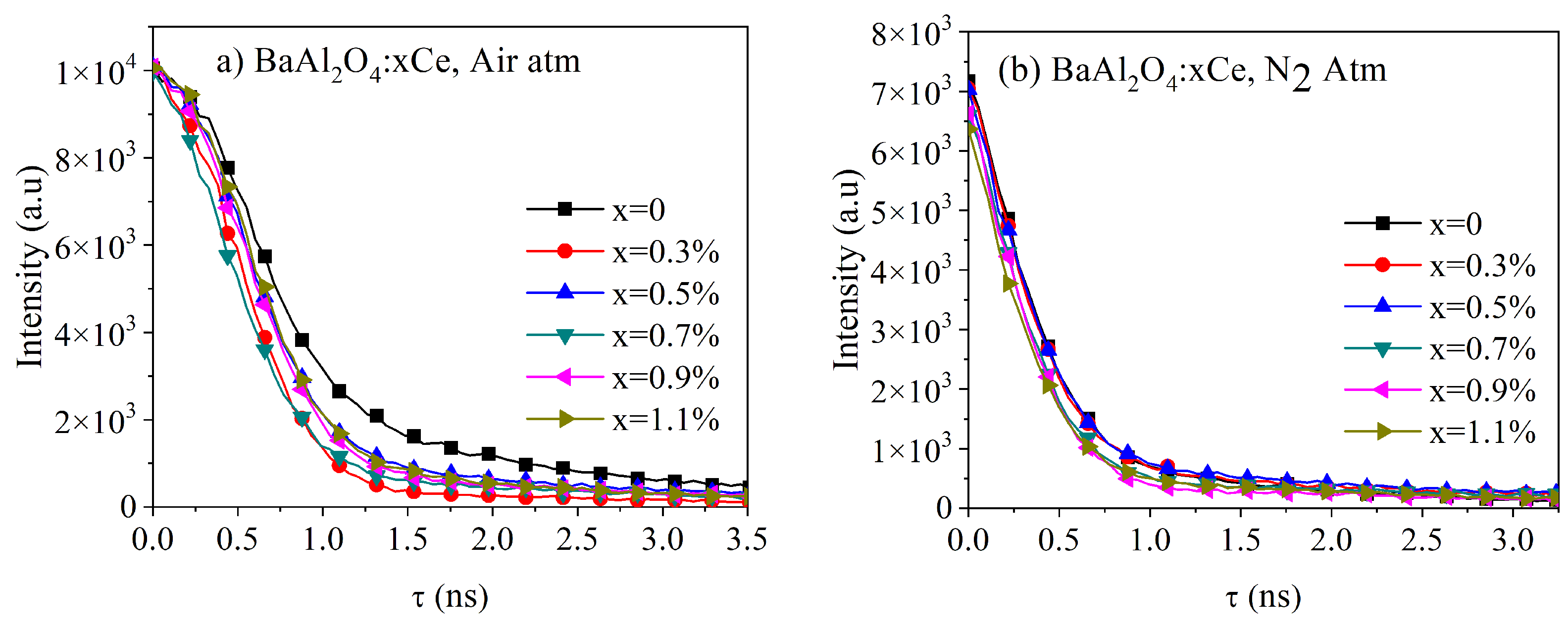
| Air Atm | N2 Atm | |||||||
|---|---|---|---|---|---|---|---|---|
| [Ce] (mol%) | Crystallite Size (nm) | Lattice Parameters | Crystallite Size (nm) | Lattice Parameters | ||||
| a (Å) | c (Å) | V (Å3) | a (Å) | c (Å) | V (Å3) | |||
| 0 | 58.5 | 5.220 | 8.797 | 207.668 | 39.8 | 5.223 | 8.799 | 207.947 |
| 0.3 | 44.0 | 5.222 | 8.803 | 207.914 | 44.7 | 5.220 | 8.797 | 207.668 |
| 0.5 | 43.3 | 5.221 | 8.806 | 207.888 | 41.2 | 5.220 | 8.797 | 207.665 |
| 0.7 | 45.7 | 5.222 | 8.793 | 207.735 | 41.7 | 5.223 | 8.792 | 207.798 |
| 0.9 | 48.6 | 5.220 | 8.794 | 207.614 | 42.7 | 5.225 | 8.799 | 208.073 |
| 1.1 | 46.9 | 5.221 | 8.795 | 207.653 | 41.2 | 5.223 | 8.796 | 207.842 |
| Air Atm | Atm | |||
|---|---|---|---|---|
| %Ce | Eg Value (eV) | %Ce | Eg1 (eV) | Eg2 (eV) |
| 0 | 4 | 0 | - | 5.64 |
| 0.3 | 3.58 | 0.3 | 4.16 | 5.14 |
| 0.5 | 3.54 | 0.5 | 4.1 | 5.25 |
| 0.7 | 3.57 | 0.7 | 4.04 | 5.17 |
| 0.9 | 3.97 | 0.9 | 4.06 | 5.19 |
| 1.1 | 3.87 | 1.1 | 4.06 | 5.19 |
| Atmosphere | % Ce | (x, y) Coordinates | Color Purity (%) |
|---|---|---|---|
| Air | 0.0 | (0.14, 0.09) | 83.33 |
| Air | 0.3 | (0.15, 0.05) | 91.46 |
| Air | 0.5 | (0.15, 0.02) | 99.14 |
| Air | 0.7 | (0.15, 0.03) | 96.56 |
| Air | 0.9 | (0.15, 0.07) | 86.47 |
| Air | 1.1 | (0.15, 0.08) | 84.01 |
| N2 | 0.0 | (0.14, 0.12) | 76.45 |
| N2 | 0.3 | (0.15, 0.05) | 91.46 |
| N2 | 0.5–1.1 | (0.15, 0.06) | 88.95 |
| Sample | (ns) | (ns) | (ns) | ||
|---|---|---|---|---|---|
| 2.07755 × 1042 | 2.07755 × 1042 | 0.94 | 0.94 | 0.94 | |
| 2.23482 × 1049 | 2.23482 × 1049 | 0.80 | 0.80 | 0.80 | |
| 2.31252 × 1055 | 2.31252 × 1055 | 0.70 | 0.70 | 0.70 | |
| 4.35158 × 1052 | 4.35158 × 1052 | 0.74 | 0.74 | 0.74 | |
| 6.78123 × 1050 | 6.78123 × 1050 | 0.77 | 0.77 | 0.77 | |
| 6.82335 × 1049 | 6.82335 × 1049 | 0.79 | 0.79 | 0.79 |
| Sample | (ns) | (ns) | (ns) | ||
|---|---|---|---|---|---|
| 3737.23 | 3737.23 | 0.40 | 0.40 | 0.40 | |
| 3655.90 | 3655.90 | 0.38 | 0.38 | 0.38 | |
| 3550.57 | 3550.57 | 0.39 | 0.39 | 0.39 | |
| 3445.15 | 3445.15 | 0.35 | 0.35 | 0.35 | |
| 3498.45 | 3498.41 | 0.34 | 0.34 | 0.34 | |
| 3248.03 | 3248.03 | 0.34 | 0.34 | 0.34 |
Disclaimer/Publisher’s Note: The statements, opinions and data contained in all publications are solely those of the individual author(s) and contributor(s) and not of MDPI and/or the editor(s). MDPI and/or the editor(s) disclaim responsibility for any injury to people or property resulting from any ideas, methods, instructions or products referred to in the content. |
© 2025 by the authors. Licensee MDPI, Basel, Switzerland. This article is an open access article distributed under the terms and conditions of the Creative Commons Attribution (CC BY) license (https://creativecommons.org/licenses/by/4.0/).
Share and Cite
Coyotl Ojeda, M.N.; de Celis Alonso, B.; Espinosa Rosales, J.E.; Cruz-Zaragoza, E.; Palomino Merino, M.R. Optical Properties of BaAl2O4 Due to Cerium Doping and Heat Treatment in Different Atmospheres. Micromachines 2025, 16, 688. https://doi.org/10.3390/mi16060688
Coyotl Ojeda MN, de Celis Alonso B, Espinosa Rosales JE, Cruz-Zaragoza E, Palomino Merino MR. Optical Properties of BaAl2O4 Due to Cerium Doping and Heat Treatment in Different Atmospheres. Micromachines. 2025; 16(6):688. https://doi.org/10.3390/mi16060688
Chicago/Turabian StyleCoyotl Ojeda, Montserrat Nevai, Benito de Celis Alonso, José Eduardo Espinosa Rosales, Epifanio Cruz-Zaragoza, and Martín Rodolfo Palomino Merino. 2025. "Optical Properties of BaAl2O4 Due to Cerium Doping and Heat Treatment in Different Atmospheres" Micromachines 16, no. 6: 688. https://doi.org/10.3390/mi16060688
APA StyleCoyotl Ojeda, M. N., de Celis Alonso, B., Espinosa Rosales, J. E., Cruz-Zaragoza, E., & Palomino Merino, M. R. (2025). Optical Properties of BaAl2O4 Due to Cerium Doping and Heat Treatment in Different Atmospheres. Micromachines, 16(6), 688. https://doi.org/10.3390/mi16060688







